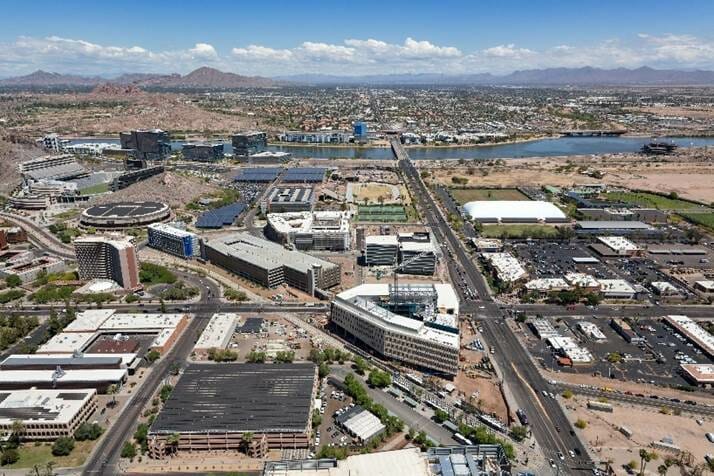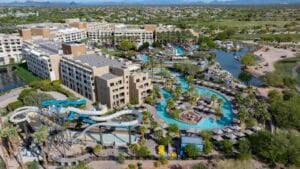The Novus Innovation Corridor is taking advantage of a once-forgotten law. In 2010, Arizona passed a state law that allowed three public universities to create athletic facility districts on city land without taxpayer or student funds.
“We’re building a city within a city and creating a home,” said Erin McKenna, marketing manager for the Catellus Development Company. Catellus is working in collaboration with Arizona State University to create something unprecedented.
While Northern Arizona University and the University of Arizona have yet to bat an eye at this, ASU is well underway in construction and is now starting to see its project come to life.
Novus is a 355-acre urban development adjacent to the ASU campus and Tempe Town Lake. The project, co-developed by the Catellus Development Corporation and ASU, will bring residential housing, restaurants, retail stores, hotels, office buildings, and ASU athletic facilities, which are at the heart of the project.
READ ALSO: Here are the people to know in commercial real estate for 2023
READ ALSO: Here is the Phoenix commercial real estate outlook for 2022
The project has seen its fair share of controversy, however. Most notably, Arizona Attorney General Mark Brnovich questioned the legality of ASU’s development projects. However, he has thus far been unsuccessful in halting them in court.
Does Brnovich realize something the state does not? Nonetheless, Tempe city officials are backing the development in its entirety with the full support of the Tempe City Council.
Tempe City Councilmember, Joel Navarro, exemplifies the council’s support.
“Seeing this thing come to life, it’s been amazing and very encouraging,” said Navarro.
Vice Mayor Jennifer Adams agrees.
“I will be supporting this,” said Adams.
The project is another 25 years out from its final build-out. However, several installations can already be seen in the athletic district. Notable examples include the office buildings on the beaches of Tempe Town Lake, such as State Farm and Mullet Arena, home to not only Sun Devil Hockey but the Arizona Coyotes (NHL).
Novus continues to dance in the face of adversity, but how much longer can they tango? All will be answered with time, but these two constructions bring early hope to a potential city-altering project. The collaboration between Catellus and ASU has propelled the project to run smoothly thus far.
McKenna emphasizes her company’s relationship with ASU.
“ASU is very hands-on, which is awesome in a partner,” said McKenna.
We share the same vision.”
The collaboration is certainly one of a kind, built upon shared values.
“We’re huge on sustainability, as is ASU. It’s one of the major pillars,” said McKenna.
Sustainability is just one of the major pillars involved in building a community. McKenna envisions an environment characterized by many facets of life.
“We want to be the new revised destination for “live, work, play,” said McKenna.
Novus officially pushes its four cornerstones of live, work, play, and stay. Work Hard, Play Hard is the backbone behind Novus. It is well known that Novus has and plans to bring many large cooperation office buildings to this region. What is lesser known is the incredible social atmosphere Novus aims to create. This will largely be due to the future residential housing and retail district, “Novus place.”
Novus Place, a retail district, is touted to become one of the premier destinations in Tempe. The district will consist of shops and restaurants, while its electric atmosphere will be maintained through community events and its direct location on the ASU campus. Novus Place will fall directly on ASU’s current track and field stadium on South Rural Road. Track and field will subsequently be moved across the street, joining other ASU athletic facilities on the east side of the athletics village. Whereas Novus Place will now possess a premier position in Tempe, directly next to the newly built Mullet Arena. Not only will this increase foot traffic through the area, but it will also connect Novus directly to ASU students. McKenna speaks about the vision of Novus Place.
“This place will have a bunch of community events that are really just calendar based, such as reoccurring live music, reoccurring yoga in the park, and just really fun events like that,” said McKenna.
Novus Place is just one of the many facets that make up this grand project. Ultimately, the project will be defined by its variety. McKenna shares this vision.
“So we have everything that you’ll need for your work, where you want to shop, where you want to dine, where you want to live, or where you want to just come to hang out with your friends in our public parks. We’re creating a community that feels like a home,” said McKenna.
With projects of this scale come many jobs and much economic prosperity. By 2035, Novus aims to have created 33,734 jobs through office, hotel, multifamily, and retail. There will be an additional 20,000 jobs created for construction purposes. Construction of completed and currently active projects to generate an economic impact of $1.86 billion. We can not predict the economic impact the Novus Innovation Collider will have once fully completed, but it will be significant. Through the short five years Novus has been under construction, they predict upwards of $2 BILLION flowing in from finished construction. Upon completion, Novus will span four distinctive neighborhoods and encompass over 10 million square feet of retail, restaurants, residential urban living, hotels, and office space.
Nonetheless, the project will not be fully completed for 25 years, five years into the project now.
As a result of this 30-year end date, Novus remains unknown to your average Tempe Citizen. Although Tempe has yet to realize this city-altering project being built before them, it soon will.
Siddharth Somani, an aspiring business entrepreneur living in Tempe, echoes this.
“Twenty-Five years from now, Novus will be as recognizable to Tempe as Mill is right now, probably even more so,” said Somani.
Somani continued to build off this.
“Novus is doing something we haven’t really seen yet. They’re partnering with a university to create a district that’s going to be able to provide so many incredible services,” said Somani.
Namely live, work, play, and stay, making it easy for the project’s original purpose to get lost in translation, an athletic facilities district. However, this portion of the project is alive and well, with the previous mention of the newly built Mullet Arena and further plans for the future.
Novus stresses that athletic facilities are at the heart of their operation and are dug in for the long haul. According to their website, “Originally created as a University Athletics Facilities District, Novus Innovation Corridor is intended to generate long-term, predictable revenue to support the renovation of collegiate athletic facilities while integrating corporate and campus innovation (Novus).”
This strategy is at the heart of their operation. Athletic facilities, retail, restaurants, housing, and more will continue to generate revenue that will, in part, be directed toward the upkeep of these facilities. McKenna certainly agrees with this notion.
“In order to be a world-class university, you have to have world-class athletics,” said McKenna.
ASU strives to be a world-class university, and many already consider it one, citing this project as another reason. When asked about the significance of this project, McKenna captured the moment perfectly.
“We’re bringing something special to Tempe,” said McKenna.




